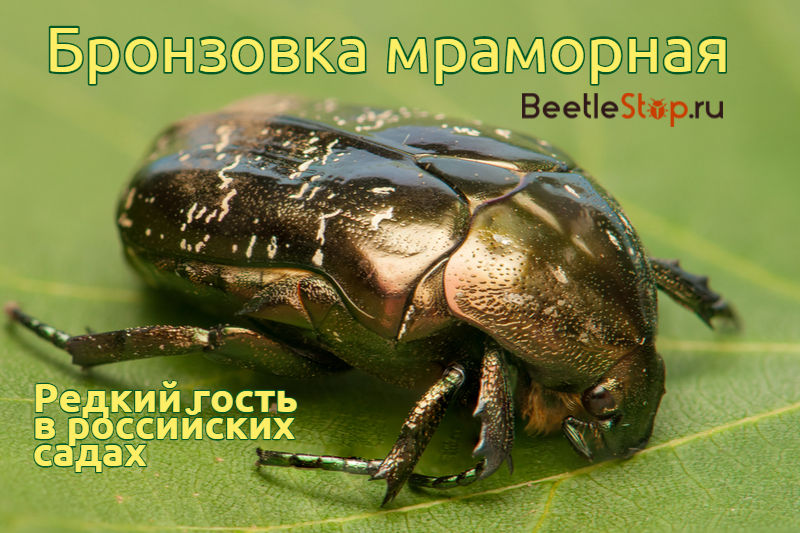Marble bronze - flight with folded elytra
At the beginning of summer, a peculiar buzz fills the gardens - large shiny bronze beetles fly in. Representatives of the genus are largely similar to each other, but differ in color and size. The most common bugs are green, green with a golden or red tint. Marble bronze differs in color, its elytra is dark with a characteristic light pattern. Insects can be found in the garden, where they drink the juice of trees or feed on nectar on flowers.

View description
Marble bronze (Protaetiamarmorata) belongs to the lamellar family. This is the largest representative of the genus bronzovok, the body length of the beetle is 19-27 mm. The color is black and bronze with a characteristic metallic sheen. The lower part of the trunk and limbs with a green tint. The body is elongated, narrowed at the back. The shield is triangular, convex, covered with recesses and dotted dots. The middle is smooth, the punctation is shifted to the sides.
The lower part of the chest and sides are covered with light hairs. Head on top in deep punctation. It is significantly narrower than the pronotum, directed forward. Antenna with lamellar mace, which opens in the form of a fan. Hard shiny elytra covered with longitudinal rows of dots and a marble pattern of white dashed stripes. On the abdomen of the male is a longitudinal strip. Forelegs with flat, digging legs. The legs are dark. The hairs on the legs are pinkish.
Information. A distinctive feature of bronzes is the holes on the sides of the elytra, through which wings are released. In this case, the elytra of the insects remain folded.
Distribution area
The Protaetiamarmorata species is common throughout Europe and Asia. Beetles are found in Siberia, in the Far East. In Russia, locally lives in the forest and forest-steppe zone.
Lifestyle
Years of adults from June to September, the duration depends on the temperature in the region. Found in old forests, parks and gardens. The species is flat, bugs do not settle above 700 m above sea level. Heat and photophilous insects prefer well-warmed edges and clearings.
Adults feed on sap flowing from deciduous trees - oak, aspen, willow, birch. Marble bronze willingly feeds on the colors of pears, lilacs, rose hips, elderberries. Beetles are active during the day, especially in hot weather. From the rain they hide in a shelter from leaves or go down to the ground. Natural enemies of bird beetles - rooks, jackdaws, magpies, orioles. On insects parasitic wasps scoli and flies tahini.
Information. Beetles eat nectar on the flowers of fruit trees, but do not cause serious damage to the crop.
Breeding
Females lay oval-shaped smooth leathery eggs in old rotten wood. Larvae of the bronze are similar to the larvae of the chewer, but do not harm the roots of plants. They are large, fleshy, C-shaped. Body color is white, head is brown. On the back there are many transverse folds that help to move. Chest legs are well developed. The body is covered with bristles. Develop in old stumps, rotten decks or hollows of dried trees. Larvae pass three ages. Remain for the winter.
Pupation takes place in the tree where the larva fed. Pupa soft, loose, yellow-white. Lies on his back in a pre-created crib (false cocoon).In warm regions, the development of a new generation takes place in one year, in temperate latitudes - in two. With a stretched summer, an imago beetle manages to form in a cocoon in autumn. He does not leave the cradle, but remains in it until next spring.
Related view
Marble bronze is not inferior in size to the appearance of Cetonischemaaeruginosa or large green bronze. The body length of the imago is 22-29 mm. The upper torso and head with a golden green tint. Pronotum and elytra smooth, without longitudinal impressions. Insects live in the European part of Russia, Asia Minor, Moldova, Ukraine. Oak forests and deciduous forests are preferred. Adults feed on tree sap, and larvae develop in hollows. Two-year generation.
Years of imago fall on May-August. Beetles fly well; they like to sit in the crowns of trees. Active larvae process dead wood. Due to the felling of old trees, insects have become a rare species in the Russian Federation. The big green bronze is listed in the Red Book of Russia.
Insect conservation status
As a rare species, bronze marble is listed in the Red Book of several regions of the Russian Federation - Moscow and Smolensk. Uprooting of old stumps, cutting down dead wood, hollow trees leads to a reduction in the number of beetles. In habitats of bronzovka it is recommended to leave part of the dry plantations and natural decay, to prohibit the uprooting of stumps.

